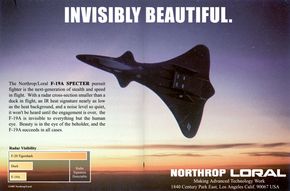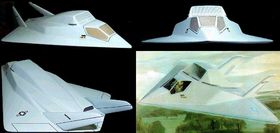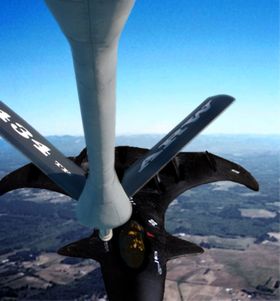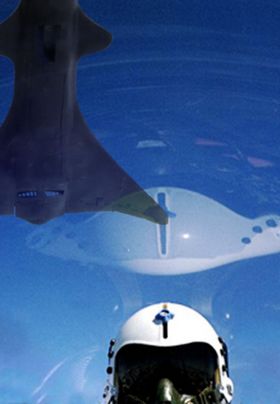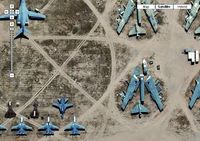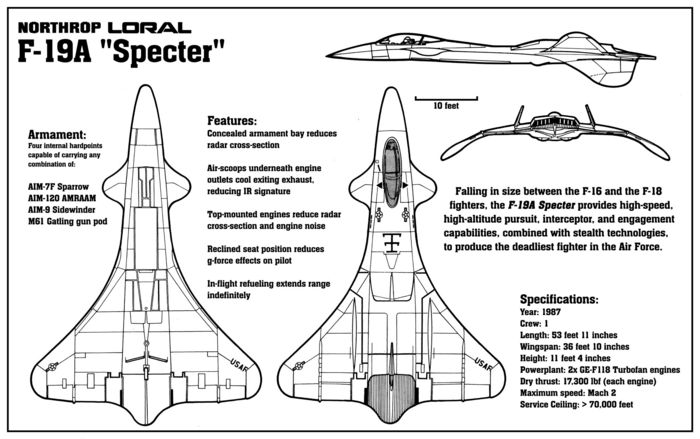Northrop-Loral F-19A Specter
The Northrop-Loral F-19A Specter is a next-generation, high-speed fighter-interceptor using advanced stealth technology. Begun during the XST design shootout in the late 1970s, the Specter grew from the same seed as the F-117 stealth fighter, but diverged as Northrop developed higher performance technologies. Numerous Specter airframes were produced, although the project was never officially accepted by the military for general military action. Any remaining Specters (refitted as RF-19 fighter-reconnaisance) remain highly classified and their operations are unknown.
Contents
Early Design
Northrop was one of five companies in 1977 requested by DARPA to provide white-sheets for the development of the XST: the "Experimental Survivable Testbed." These designs were intended as proof-of-concept, and 1/3 scale models were tested for radar reflectivity. Northrop, using technical strategies known at the time, went with a faceted design much as Lockheed did but focusing on frontal cross-section (flying into combat being more dangerous than exiting). Lockheed was already an expert at operating under a top-secret cloak, but Northrop had to re-learn processes from the ground. Although Northrop's design showed some greater strengths than the Lockheed stealth aircraft, the contract went to Lockheed.
Northrop's developments and new veil-of-secrecy policies did not go to waste; the XST team was kept in place, and development began on further advanced stealth technologies under an open-ended DARPA experimental contract. In compliance with FTC securities laws, an exceedingly short press release was made, announcing the stealth contract, but then silence was achieved.[1]
New Stealth Concept
The faceted angles of Lockheed's designs were a simple method for designing a low-radar-profile aircraft; without flat surfaces perpendicular to the radar source, reflections would not be detected. Northrop designer Fred Oshira developed a new technique for designing low radar reflectivity called the "Source Distribution Technique." This complex method of calculating the positive radar reflectivity of a curved surface was highly accurate, but difficult to calculate by hand and required computer aided design assistance. While the concept was around before the XST competition, by the early 1980s the technique was in full use. Lockheed continued their production of the highly faceted F-117 (and largely continuing in the YF-22 Raptor), but Northrop diverged into curvier designs seen in the F-19, B-2 Bomber, and YF-23 attack fighter.
Collaboration with Loral
The F-117 had numerous drawbacks; it was subsonic, it had a lower ceiling, and it was more difficult to fly than its smaller peers, the F-16 and F-18. Northrop had completed a proof-of-concept aircraft under the project name "Tacit Blue," a oddly shaped curvy aircraft
with an extremely low radar signature[2]. While Tacit Blue was not intended for production, it proved Northrop had the skills to produce a high-performance tactical interceptor surpassing the F-177's capabilities.
Loral, a spacecraft and aerospace manufacturer, was not an aircraft manufacturer and had not been included in the XST competition. The company, however, had great expertise in high-speed, high-altitude transportation, and an in-depth understanding of radio wave propagation. Loral had produced proof-of-concept designs for a futuristic high-speed upper-atmosphere interceptor, and used an image of the craft in an advertisement and poster, not thinking it would ever be developed. Northrop had acquired some of its designers and technicians from Loral during XST, so it began a partnership with the company to adapt the conceptual design to production, using Northrop's Source Distribution Technique.
DARPA Interest
In the early 1980s, there were still great concerns in the military regarding Soviet supersonic bombers reaching American soil. The USSR's newly-developed supersonic TU-160, a variable-geometry supersonic bomber comparable to (but exceeding in speed and size) the US' B1 bomber, was a formidable threat. The US had high-speed interceptor aircraft, but the advancement of radar technology and the possibility of being confronted by guard aircraft (such as the agile SU-27) before having the opportunity to attack an approaching bomber, DARPA returned to the XST competitors for potential designs. Lockheed provided an advanced version of the F-117, but did not meet specifications; General Dynamics' aircraft division was producing the F-16 and declined, and Grumman was experiencing financial difficulties so could not participate. Northrop had proved their abilities during the Tacit Blue tests, so the contract went to Northdrop almost by default. In May 1981 Northrop-Loral was awarded the contract for a high-speed interceptor fighter.
Development of the F-19
Loral's initial design was stealthy, but improvement using modern computers and computation converted it to a high-performance craft with a low radar profile. Small, inward-sloped vertical tails provided little stability, contributing mostly to maneuverability. Newly-designed fly-by-wire computers, later applied to the completely-tailless Northrop-Boeing B-2 Spirit, counteracted the reduced stability. The adapted delta-wing configuration helped as well; inherently more stable than standard swept-wing configurations, the wings curved down at the tips, creating an additional slightly vertical surface for added stability. Small unmovable canards were built into the body to break up the straight leading edge of the craft, provide some lift, and guide air to the engine inlets at low angles of attack.
The air inlets, as in the Northrop's XST submission, are located on top of the craft and to the rear of the pilot. This prevents radar reflection off compressor blades from being visible to ground-based radar installations. RAM-coated angular 'vents' in front of the compressors scatter radar reflections to other aircraft. Cold War requirements for the interceptor included in-air refueling; the best place for the Northrop designers to position the inlet was behind the pilot, but directly in front of the intake vents. Small amounts of fuel spilled during refueling are immediately sucked into the engine causing a small burst of power and making the F-19 lurch slightly, much to the concern of the nearby inflight-refueling crews on the tanker.
A most creative solution to Infra-red signatures is the pass-through exhaust air scoop. Below the engine outlets, on the underside of the craft, the F-19 has airscoop 'rams' that force unheated air from beneath the aircraft upwards, passing through the plane itself, into the exhaust stream of the engines. This allows the craft to operate with afterburners, because the cooling effect is proportional to the aircraft's speed. The scoops do create a downward force on the rear of the craft, forcing the nose up slightly, but the fly-by-wire systems account for it and it assists in lift during high-altitude flight. As these 'rams' are passive, the vents are closed from above whenever the engines are in operation while the craft is stationary, such as taxiing or warming up, to prevent exhaust gases from being forced the wrong way out the rams and endangering ground crew.
The craft was built without a machine gun, under the assumption that at such high speed engagements the gun would be useless. The craft has four internal hardpoints hidden within the body of the craft that could be used to carry a machine gun pod, hiding its reflectivity and heat when the ordinance bay is closed. The hardpoints may carry any combination of air-to-air armament. The small payload is considered the plane's greatest drawback, although the need for more than four missiles was never tested.
The low side profile of the craft forces the pilot into a reclined seating position; this is actually an advantage for the pilot, because it reduces the possibility of blacking out during high-G turns.
Testing
Six F-19 testbed airframes were built[3] (only five were flightworthy), and the first, test craft #2, flew at Groom Lake on 14 September 1982. Initial flights were promising, but tweaking of the fly-by-wire controls were necessary most every time. Test aircraft #4 was lost on the ground due to fire, resulting in a change in the fuel hosing in all five remaining aircraft. Test aircraft #5 hit a top speed of Mach 3.1, but was unable to sustain the speed for very long. An effective top speed of mach 2.5 was determined, slightly lower than predicted but still above the specifications' top speed of mach 2.0.
The results were presented to select members of Congress, Air Force officials, and DARPA representatives, on 18 June 1983. The project was deemed a success, and 50 F-19 aircraft were ordered for delivery by the end of 1985.
The remaining flightworthy F-19s were scrapped, while the non-flying test craft #1 was given to the Longmont Aircraft Museum in Longmont, Nebraska, the hometown of test pilot Jon Green, the first pilot to fly the F-19.
There was a brief attempt to consider the F-19 for aircraft carrier deployment in the U.S. Navy; early tests found that upon hitting the deck the drooping wingtips would contact the tarmac hard, resulting in damage. As the wingtips were modular, intended to fold up for transportation, the damaged tips were replaced without difficulty and the aircraft was returned to service.
In Production
Acquiring the unique materials used in the construction of the RAM coating on the aircraft proved troublesome. While the project remained only slightly over budget, the timeframe was becoming unattainable. Northrop took a five million dollar penalty and delivered only 15 F-19s by the end of 1985. All but three were delivered to 17th Fighter Squadron "Black Falcons" wing. The remaining three aircraft, delivered to the 9th Reconnaissance Wing, were fitted with reconnaissance equipment and relabeled RF-19; two were flown during the later days of the Iran-Iraq War, and one flew over Afghanistan in 1988 to monitor Russia's military presence in the region.
Russian Destabilization Ends The F-19
With Gorbachev's ascension into Soviet leadership in 1985, the beginning of the fall of the USSR began. Ten more F-19 Specters were delivered in 1986 and 1987 (these got the "A" designtion, due to an engine upgrade), but as Russia's ongoing destabilization continued it became clear that supersonic bombers were not the threat they had been in the 1970s. The team of Northrop and Boeing (with Loral contributing as a subcontractor[4]) had produced the B-2 Spirit bomber using technology honed during the design of the F-19, thus bringing the count to three super-secret stealth projects in production despite the declining threat of the Soviet Union. As a concession to continuing the F-117 and the B-2, the F-19 contract was terminated after delivery of only half the initial order.
Abandoned Secrecy
DARPA and Northrop now had several problems: the project was started and ended in complete secrecy; the excesses of Regan-era military spending were beginning to draw criticisms, and a sudden announcement of a very expensive, useless, and now terminated project would look bad; terms of the contract allowed Northrop to demand reparations for the incomplete contract, but a lawsuit would draw attention to the secret project. An agreement was made, buying out the remainder of Northrop's contract, while maintaining total secrecy.
The Air Force, while flying the aircraft secretly stateside, had not publicly recognized the existence of the F-19 Specter yet, and with the termination of the contract they had no plans to do so. The three reconnaissance craft were transfered to CIA control, but the rest were dismantled for the expensive and recyclable carbon-fiber parts.
Aircraft Specifications
- Year: 1987
- Crew: 1
- Length: 53 feet 11 inches
- Wingspan: 36 feet 10 inches
- Height: 11 feet 4 inches
- Powerplant: 2x GE-F118 Turbofan engines
- Dry thrust: 17,300 lbf (each engine)
- Maximum speed: Mach 2
- Service Ceiling: > 70,000 feet
References
Inspiration From
- http://www.californiasciencecenter.org/Exhibits/AirAndSpace/AirAndAircraft/F20/images/F20ad.pdf
- http://www.vectorsite.net/avb2.html
- http://www.fas.org/irp/mystery/tacitblu.htm
- http://www.securityarms.com/forums/showthread.php?p=1236
- http://www.angelfire.com/nh/blackjet/models.html
- http://modelingmadness.com/reviews/mod/jacksonf19.htm
